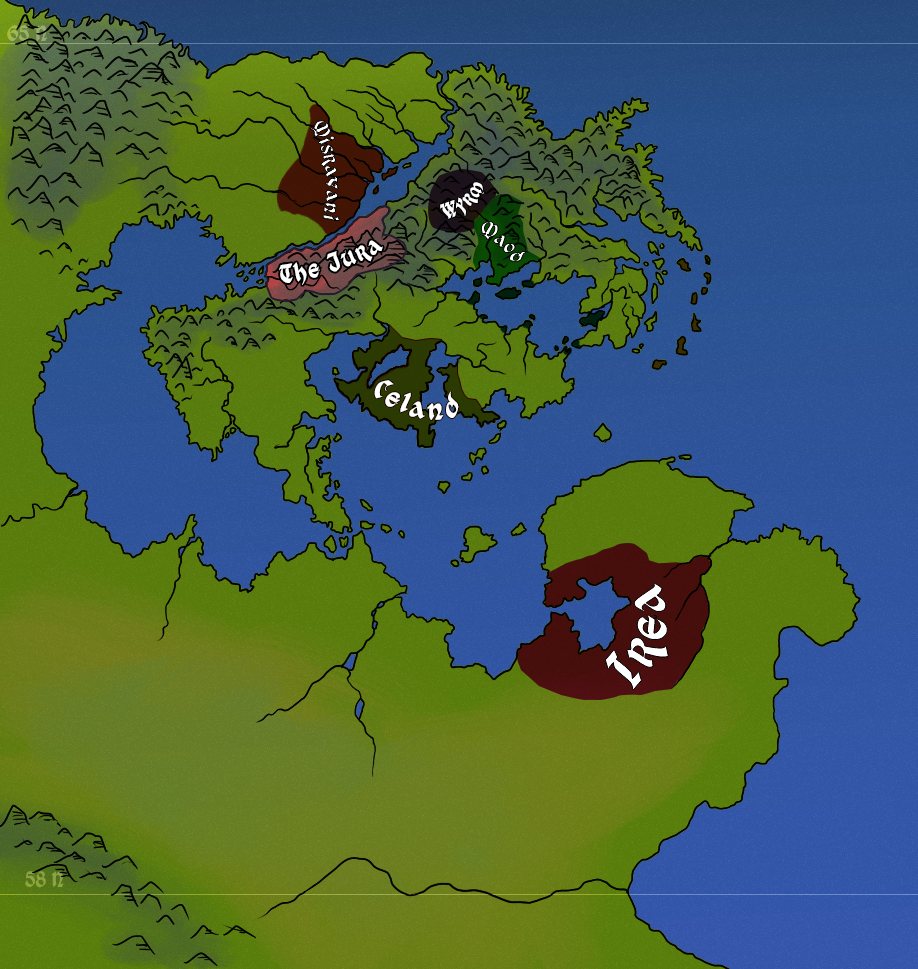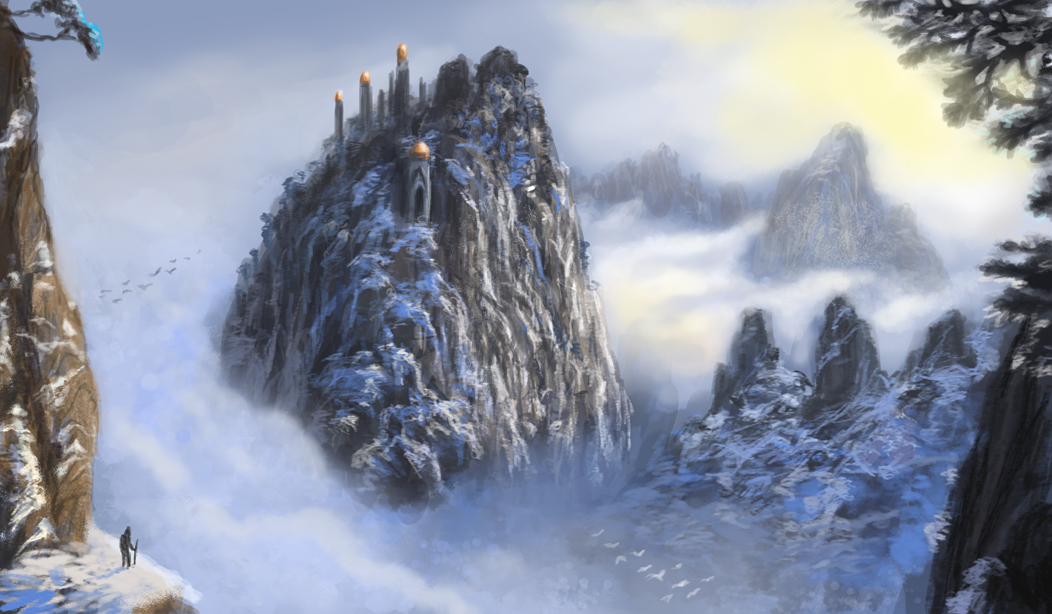Background
The Skrælingjar are a people made up of eight different and independent clans, spread over as many islands. They are a fierce people, driven to raid the green lands by the nature of the rocky isles they call home and by the command of their vengeful and wroth Father-God, Sil. They believe they are his chosen people, and will only escape his wrath through the promise of even greater blood split in His name. Thus for centuries they have pillaged the coastal lands around them in order to protect their own homes and ships from disaster.
In accordance with the nature of Twin-Gods, the men are of the sea and the women are of the land. All the land belonging to a family or a clan is therefore owned by and passed down unto the female children. Conversely, all ships belonging to a family or clan are owned by and captained by the men. This duality appears and again and again in Skrælingjar culture. The domain of women is fertile and productive, therefore all children born of women belongs to her clan. The domain of men is destructive and takes, therefore all thralls taken by a man belongs to his clan. During the coldest and stormiest months, the men winter at the houses of their clan or with their wives clans if they have wedded outside of their own, although this is less common. Most of the menfolk will take their leave come the spring to sail and raid until autumn forces their return. In times gone past this would be only to war, but as the Skrælingjar learnt to eek riches out of Sil’s domain and even the harshest of Sara’s land, they have become voyages of trade as well.
The isles are poor for agriculture and mining, but Sil begrudgingly provides fish and the great grey ones to His children. With thralls to work the fields and the mines, some isles yield iron and grains, but many are still are dependent upon temperamental Sil for their sustenance, either by force or by choice. They use shallow hulled fast ships, powered by oar and sail to traverse the seas. They can also navigate large rivers, and can be beached safely without proper harbour - a useful trait for the hit and run style raiding they practice.
In appearance they are neither tall or short, though somewhat broader than the average human. Their hair is usually dark colour, dark brown or black, as are their eyes. The women wear their hair long and sleeked back with oils, the men similarly pull it back into a warrior's queue with the sides kept short. Furs and seal skin are the most common materials for making garments, although other leathers and woven garments are more common on the southern isles and the richer ones. Wealth is worn the person in torques and arm bands, and all people, men and women go armed about their business - although only men may wield swords, the women make do with long knives, axes, spears and bows. Armour is rare in the isles, with ring mail and helmets only being able to be afforded by the retinues of the Gunnar Jarls.
Clans and the Tinvaal
The clan culture of the Skrælingjar is based on matrilineal descent, children are primarily raised by their mothers and their uncles, not necessarily by their fathers. Each of the clans have a dual nature and this is reflected in their two chieftains. The island the clan is based on and all it produces is overseen by the Heimóðir, the Mother of the House (alternatively the Mother of the Hearth). The title is generally passed down to the first born daughter, but it is not unheard of for it to be passed to a younger daughter, sibling or even cousin if the heir apparent is deemed unworthy. They rule from strong houses, small defensible stone keeps that stand in the middle of their primary settlements.
The clan fleet and all it produces is overseen by the Gunnarr Jarl, the Chief Warrior or the War Chief. This title is almost always selected through merit, though heirs of famous warriors or those directly related to the Heimóðir often get precedence. From spring to autumn they rule the seas from their ships, during the winter they return to the islands, some will reside in family homes or the Strong House, whilst others will reside in great feasting halls specifically raised for the purpose of housing wintering warriors - these exist due to proscriptions about allowing warriors from other clans to sleep in strong houses as well a show of respect to Gunnarr Jarls.
However, these figures, the Heimóðir and the Gunnarr Jarls, do not exercise complete authority over the clan. Independent farmsteads and ship captains have a great degree of autonomy. Obedience is only required in calls to war and not breaking explicitly formed alliances. There is also the Seiðr to compete with, an independent structure of mystics, prophets and priests that interpret the will of Sil for the clans.
In recent times, however, the isles have become more unified than ever with the founding of the Tinvaal, a gathering of Gunnar Jarls of all the clans. It came about when the legendary war-chief Ragnar Blood-Reign of the Clan Melrakki married the Heimóðir of the Clan Otr. They then entered into alliance with Ragnar’s half-brother, the War-Chief of the Kópr, and his father, the War Chief of the Hroshvalr. With four of the clans united in alliance, some of the more powerful ones at that, the others were forced to follow suit to ensure their survival. Thus the Tinvaal was created.
The Tinvaal votes on the matters of war and trade and settle disputes between captains of different clans. It has massively increased the amount of trade that the clans do, and has limited the amount of warfare they engage with. Some have benefited from this and continue to push for this path, others, for reasons economic, religious and political, push for a return to the old ways. However, once again the clans have great autonomy and its rule is not secure, the oral histories and traditions of the Skrælingjar go back thousands of years, whereas the Tinvaal has existed for less than two hundred.
Currently the Clans represented in the Tinvaal are:
Clan Ari - Rulers of the southernmost isle (marked 1 on the map), they are known as voyagers and adventurers who travel further than all others. The Ari have the most links with the lands far to the south and often the most exotic goods in the isles land in their ports first. Traditionally one of the moderately powerful clans, as trade grows their strength waxes. Their sigil is the Eagle.
Clan Otr - Rulers of the island to the north east of the Ari (marked 2 on the map), this is the largest most fertile and agriculturally productive of the isles. Traditionally one of the most powerful of the Clans, their importance wanes in the increase of imported food goods and trading with the mainland. However, they still support a large population and raiding fleet. Their sigil is the Sea Otter.
Clan Bjarndýr - Rulers of the island to the north east of the Otr (marked 3 on the map), the uplands of this mountainous island yield the best lumber for ship building and the richest iron veins in the islands, however the terrain also constrains the clan population. Traditionally of moderate importance, cheap iron imports are undercutting the Bjarndýr's domestic production. Their sigil is the Ice Bear.
Clan Kópr - Rulers of the isle to the north of the Bjarndýr (marked 4 on the map), this island is typical of the Skrælingjar in that it is relatively agriculturally poor and lacks many natural resources. Trade has enriched this isle somewhat, but not as it has others, leaving some sceptical and in favour of the old ways. Traditionally of moderate importance, they have retained their influence thus far. Their sigil is the Seal.
Clan Fiskr - Rulers of the isle to the north east of the Kópr (marked 5 on the map), this island is small and agriculturally poor, but supports a relatively large population to its size. This is because the Fiskr are the most adept fishermen and whalers of the Skrælingjar, and their fishing fleets far outstrips those of other islands. As the populations of other islands has increased they have benefited from trading food to their neighbours, leading to further intensification on fishing. This means that they are militarily the weakest isle, but economically a strong one. Traditionally one of the weakest clans, they are now fast on the rise to wealth and power. Their sigil is the leaping Fish
Clan Melrakki - Rulers of the isle to the north of the Fiskr (marked 6 on the map), the Melrakki are the master traders of the Skrælingjar. The largest port of the isles, Port Thirsk is build in the western facing bay of the island. They are the richest of the clans, and the ones which have had the most gain out of the Tinvaal. However, this has caused great resentment towards them by others, and mutterings that they will soon be punished for abandoning the way of Sil. They are traditionally one of the most powerful clans, and have if anything increased in power in recent years. Their sigil is the White Fox.
Clan Hroshvalr - Rulers of the isle to the north west of the Melrakki (marked 7 on the map), the Hroshvalr are reputedly the greatest and most feared warriors in the isles. The location of their home, sheltered from the greater storms by the other isles, means they raid into the depths of winter. However, conversely this has also made the Hroshvalr worse sailors than other clans, as they rarely have to brave the wild open oceans. Traditionally one of the most powerful clans, they have retained their importance under the Tinvaal, but recent the incursion onto their raiding that it has increasingly placed. Their sigil is the Walrus
Clan Nāhvalr - Rulers of the northern most isle (marked 8 on the map), the Nāhvalr are considered the most conservative and traditional of the Skrælingjar. They follow the way of Sil closer than all others, and although they are fewest in number, they make up for this in zealotry. They are regarded as mysterious by the other clans and are known for producing famed mystics and warrior hermits. They have resisted all trading ways, and are the most hostile to the Tinvaal of all the clans. Traditionally one of the weaker clans, they grow more isolated and weaker still, however a recent alliance with the Hroshvalr may change their prominence once again. Their sigil is the Narwhal.











